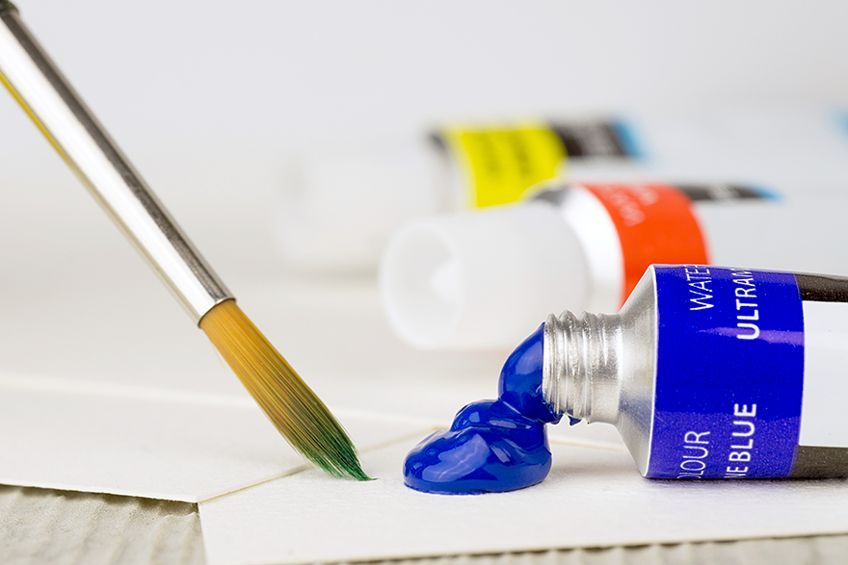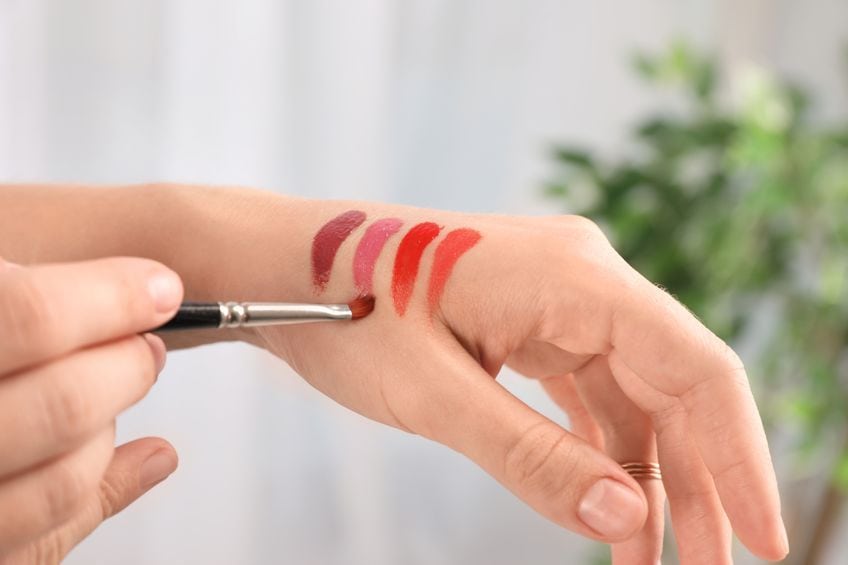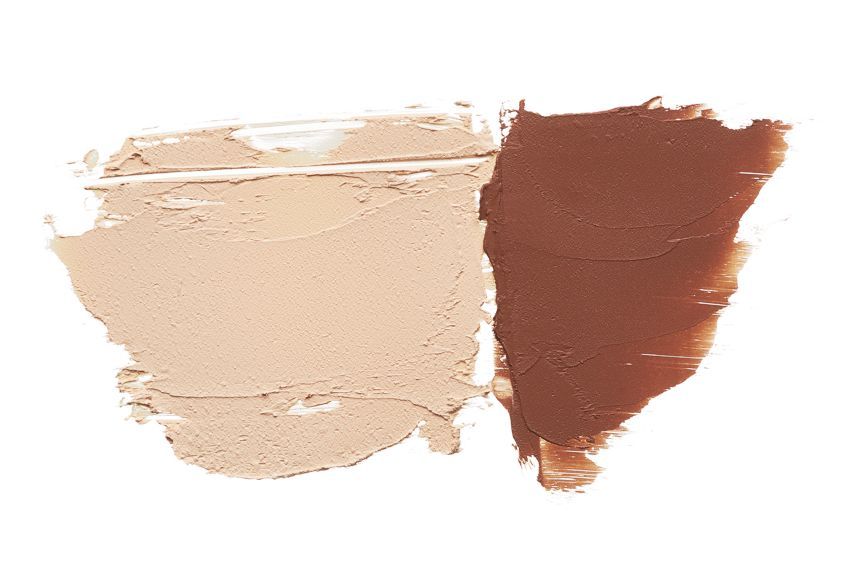Is Acrylic Paint Safe for Skin? – Acrylic Paint Toxicity
Most of us have used acrylic paints at some point, be it for artwork on canvas, spray-painting an object, or even painting a wall. This popular paint type is available at most craft and hardware stores. Now, as you might know, if you have used acrylic paint before, it washes from surfaces relatively easily. This might spark questions such as; “does acrylic paint wash off skin easily too?”. “Does that mean painting faces with acrylics is possible?” and “can you put acrylic paint on your face?”. Basically, you may want to know just how safe this paint type is and how to remove acrylic paint from skin, if necessary. This article will give you all the information you may need to answer these very questions! Let us get right to it!
Table of Contents
- 1 Exploring Different Types of Acrylic Paint
- 2 The Ingredients in Acrylic Paint
- 3 Is Acrylic Paint Safe for Skin?
- 4 Which Types of Paints Can Be Used on Skin?
- 5 Paints Suitable for Infants and Younger Children
- 6 How to Remove Acrylic Paint From Skin
- 7 Some Tips for Using Acrylic Paints
- 8 How to Make Skin Color With Acrylic Paint
- 9 Frequently Asked Questions
Exploring Different Types of Acrylic Paint
Since art took to canvas, oil-based paint has been the most used medium. Oil paint is, however, more toxic than other mediums, and they also require more solvent-based cleaners. It goes without saying that when a less toxic and easier to clean medium was created, it rose in popularity quite quickly.

There are many acrylic paints that can achieve similar results and techniques to oil paints. Here are the various types of acrylic paints and their descriptions:
| Acrylic Paints | Description |
| Heavy Body Acrylic Paints | Smooth; butter-like consistency; thick viscosity |
| Soft Body Acrylic Paints | Excellent coverage; low viscosity; creamy consistency |
| Fluid Acrylics | Thick cream-like consistency |
| Acrylic Inks | Excellent for layering washes and techniques; thin consistency |
| Acrylic Gouache | Matte opaque creamy consistency; watercolor finish; water-resistant when dry |
| Acrylic Markers | Marker pens, excellent for detailing |
| Acrylic Spray Paints | Excellent coverage but needs ventilation when applying |
| Other Interactive or Open Acrylics | Excellent for techniques such as wet-on-wet painting |
Acrylic paints are not all equal, however, there are various grades of paint available, from the end-of-line children’s paints to student-grade products and then, of course, artist-grade paints. The main difference between these different paint grades is the pigment density and the quality of the paint itself. It goes without saying that the professional artist-grade options are the best quality with the most vibrant colors, but of course, they are also more expensive.
Canvas and paper are not the only places you can paint with acrylics, this medium can be used on many other surfaces, including clay, fabrics, and wood. Some may be wondering if painting faces with acrylic, or other parts of the body for that matter, are included in this list of surfaces suitable for this paint type.
Is acrylic paint safe for skin, and does acrylic paint wash off skin easily?
Whether you are an artist needing to paint a model for the runway, or just looking for options for kids’ face paint for a party, it is very important to make informed decisions when putting any paint on the body’s largest organ, the skin. This is why it is so critical to do research and to read the manufacturers’ product labels before you make a purchase.
Is acrylic paint safe for skin? It is essential to understand that just because acrylic paints may have the words “non-toxic” and “water-based” on their labels, does not mean that you can put acrylic paint on your face or body. There are specific products and paints especially created and formulated for these purposes, and those are a far better option. Even though acrylic paint may be labeled as non-toxic, it can still contain some ingredients which could cause skin irritation or other problems.
The Ingredients in Acrylic Paint
Acrylic paint is created with an acrylic polymer emulsion that contains a combination of color pigments. The acrylic polymer is what causes the paint to harden once dry but while the paint is still wet it will remain soluble with water. There are still other substances used to create acrylic paint. The polymerization process is activated thanks to initiators, pH balance buffers, as well as preservatives, defoamers, and thickening agents, all of which are a few ingredients found inside acrylic paint. There are even some acrylic paints that contain ammonia, lead and some even contain formaldehyde.

You need to be aware of the ingredients so that you purchase the least possible toxic paint, so check labels to make sure you are buying lead-free paints. So now, the question we have been waiting to ask, “is acrylic paint safe for skin” seems to have been answered! Would you like to put any of these ingredients on your face or skin? The actual pigments used in acrylic paint are not toxic and are quite harmless, but there are still some products that use pigments that can be bad for your health and contain toxic chemicals and heavy metals like lead. There should be a warning label on any and all paints that contain these ingredients, but be sure to purchase authentic products from a reputable store.
Cadmium Pigment
Discovered in the 19th century and used to create browns, yellows, and vibrant red color paints, this is a very rare pigment, so it is not likely to be found in paints today. This is probably for the best as over-exposure to cadmium pigment can cause severe health issues, it is also carcinogenic!
It is mostly found inside oil-based paints and usually only used by professional artists, who handle it with the utmost care.
Cobalt Pigment
Discovered in the early 18th century, this pigment is obtained from the nickel refinery process. Most paints that contain cobalt pigment are quite pricey. These are also moderately toxic pigments, which may lead to skin reactions or asthma if inhaled. If you ingest cobalt pigment, you may experience nausea, vomiting, and even diarrhea.

Chromium Pigment
This greenish-colored pigment can cause havoc in the form of dermatitis and allergic reactions. Once chromium makes contact with the skin, it becomes inflamed, red, and itchy.
This is even more true if the pigment is used often.
Manganese Pigment
Manganese is found in foods such as nuts and leaves. The pigment used today, however, is actually synthetic. It is also a toxic pigment and is very similar to the pigments cobalt and cadmium. You will not be able to source natural manganese pigment, so it is unlikely to be inside any of your acrylic paints.

Is Acrylic Paint Safe for Skin?
There are no pharmaceutical-grade ingredients inside acrylic paints, which automatically means that no, they are not safe to be used on the skin. There are some paints that have been specially created for use on skin, but even these should not remain on the skin and need to be washed off as soon as possible.
Using acrylic paint on canvas has many benefits, however, there is no reason to use this medium on your skin or face. Here are some of the reasons and disadvantages as to why using acrylic paint on your skin is a poor choice.
| The disadvantage of getting Acrylic Paint on Skin | Reasons Why |
| Toxicity | While it generally is not toxic, many ingredients inside the paint are not safe to be inhaled or applied to the face or body. |
| Dries Hard | Acrylic paint can be considered to be a type of plastic, as it hardens once dry. While this is perfect for painting on walls or canvas, it is not ideal to be used on the skin. |
| Cracking of the Paint | Should it be applied to the skin, it will begin to crack once dried because the body is not rigid. |
| Once Dried, Removal is Tricky | Once acrylic paint starts drying and becomes hard on your skin, it can be tricky to remove, peeling the paint off can be painful, so it is best to use warm soapy water or even rubbing alcohol. |
Can You Put Acrylic Paint on Your Face?
We often do not realize just how sensitive our facial skin really is, so using acrylic paint on it is not recommended. Many will ignore warnings and still use these paints on their faces and notice no adverse reactions. While your skin may not show any reactions, you must realize that the toxins are still being absorbed into your skin and body. Bear in mind that removal of the paint will likely be a nightmare, too. There are some people who add acrylic paint to a moisturizer, this will not make the paint any less toxic, so it is still highly recommended to instead use specially formulated face paint instead. These paints are not toxic and are also much easier to remove, usually just with warm water.

Bodypaint is also available should you need to paint other parts of your body and has been in existence for many years, mostly for special shows and stage performances. Both face and body paint will not crack when dried on the skin. Remember not to allow your children to use acrylic paint as finger paint, either. While it is often unavoidable, should you get acrylic paint on your hands, it is recommended to wash them right away. Even a tiny bit of paint can expose your skin to toxic chemicals, and this can cause problems for your health in the future. Children under the age of three should never use acrylic paints, and children that are older should always be supervised when painting.
What Happens if Acrylic Paint is Ingested?
As you know, sometimes we cannot avoid getting paint onto our skin, however, should you accidentally ingest some acrylic paint, you need to drink as much water as possible and also gargle with saltwater. You are unlikely to have any issues if the amount of paint swallowed was the size of a fingernail or smaller.
If you are concerned, a call or even a visit to your doctor is likely the best idea. Another option is to call poison control.
Which Types of Paints Can Be Used on Skin?
Most of the time, you will not have any issues if you do get a bit of acrylic paint on your skin, however, some people do react quite badly, regardless of how much paint made contact with the skin. It is always best to use special cosmetic paints on your skin, but you must understand that some people can also have reactions to these. Should you be someone who suffers from allergies, or you know you have sensitive skin, it is best to avoid any form of paint until a skin test has been performed. You should know within a few minutes if your skin will react negatively.

Adults who use body paint for professional reasons will know that these paints come with a hefty price tag. These include alcohol-based, latex, henna, and metallic paint. There are certainly more cost-effective body paints on the market, they may just not be as vibrant and long-lasting. Here are a few things to look out for when purchasing paint to be used on the skin.
What Is the Paint’s Opacity?
Many people do not think about this when buying body or face paint. You will want to purchase a high opacity paint so that the colors are blond and vibrant on your skin. This means that finding paint with high opacity is the best choice.
You will also have to use far less paint to achieve the same results as a low-opacity option.
Is the Paint Hypoallergenic?
Because we all have different skin which reacts in various ways, some of us may experience mild or even extreme sensitivity to paint. This makes purchasing hypoallergenic paint even more important, so make sure the label says that it is, before applying it to your skin. If you are uncertain how your paint will react with your skin, it is a good idea to do a small test swatch.

Is The Paint Waterproof?
If you want to avoid smudges or runs, waterproof paint is extremely important. When using body or face paint for theater, stage lights are harsh and can cause sweating. If you are purchasing face paint for children, this is equally significant, as children cry and get dirty.
Using good quality waterproof paint will help the paint last for much longer.
How Easy is The Paint to Remove?
Nobody wants to spend hours trying to remove paint from their face! Even waterproof paint should be easy to remove! Make sure you find paint that does not require harsh chemicals to wipe off.
Paints Suitable for Infants and Younger Children
Many parents like to take a foot or handprint of their baby to keep as a special memento or keepsake. If you wish to do this, purchasing a special paint is a good idea, preferably a tempera paint or the Crayola brand of washable paint.

Here are a few things to remember about paint safety when you are painting with little children. Each one of these products has to be approved and should also have a coded seal from the American Society for Testing Materials (ASTM).
| Type of Paint | Reason |
| Activity Paint | Commonly water-based paint that can be applied to a multitude of surfaces. They are easily removable |
| Tempera Paint | Not toxic, quick-drying, and does not crack. This paint is also easy to wash off and remove |
| Watercolor Paints | Simple to remove and water-based |
| Finger Paints | Especially created to be used by children, so safe and non-toxic |
How to Remove Acrylic Paint From Skin
Since acrylic paints are waterproof, one often does not need more than water and some soap to remove it from your skin. When the paint is still wet it should wash off under running tap water, when dry, it may need a little more than water to remove. Be careful not to allow the paint to dry, as it will block your pores and can cause even more irritation. Ultimately, the best way to remove acrylic paint is to wash it off as soon as you can, if you cannot get to a tap and the paint has dried, there are a few ways to help you remove it when water and soap are not doing the job.
You could also attempt to peel the paint off, but if you have spilled paint on any hairy parts of your body, this could end up quite painful, leaving you with red and inflamed skin.
- Use some margarine or butter
- Baby oil can help loosen the paint
- A dab of mayonnaise
- Some petroleum jelly or Vaseline
- Rubbing alcohol or acetone-free nail polish remover
- Hand sanitizer.
- Any vegetable oil if you do not have baby oil on hand
Some Tips for Using Acrylic Paints
Using acrylic paint should be fun and there are so many techniques you can use, the last thing you want is to worry about the paint causing problems to your health or those of others, especially if you have children in the home around you while you paint.
- Make sure to read all labels on your paint product to inform yourself about it and what it contains.
- Never get paint too close to your mouth, eyes, or nose.
- Wash off any spills on the skin right away.

- Use your paints in an area with a draft or good ventilation.
- Always do a skin test on a small patch of skin before painting, to see if you have any reaction to it.
- Store your paints high up and away from children or animals.
How to Make Skin Color With Acrylic Paint
Since this article is all about painting skin and faces with acrylics, we have decided to add some information about how to create a skin color palette using acrylic paint! Of course, skin colors vary; there are so many skin tones out there, meaning that it can be quite difficult to mix up the perfect one. Here is a little guide on how to make skin color with acrylic paints.
Remember that acrylic pigments can dry darker than they appear while wet, so make sure that when mixing your paint, you aim for a slightly lighter color.
Make notes while you mix your paints so that you can look back one day, should you wish to recreate the same color. Yellow is a better option to lighten the paint mixture than white. If you wish to darken the color, use black, but only in minute amounts at a time. You can always darken your color more if needed, but lightening once too dark can end up in a complete mess!
Using your primary colors is the best way to create the perfect skin tone palette. It will also help to have a photograph as a reference for the color you are trying to achieve. Using equal amounts of your primary colors will create a base brown color. This should make for the perfect base, which you can now adjust and refine. If you feel like your base blend is too dark, some yellow or white in tiny amounts can help. If you want to deepen the tone of red, add some more red. As you go on with your mixing, just add a little of whichever primary color you need to achieve the result you want.

Experimentation is key and once you have the perfect blend, you can then start mixing colors to be used for your highlights and shadows. Add some black or white to alter the tone of the paint, create a gradient so that you have many options for your varying highlights and shadows. If you wish to make a blush tone, you can mix a little more red into your paint. Play with the colors and little bits of each primary color in varying amounts, you could create many odd colors, but many still suitable for skin.
As you have now learned, acrylic paint is not intended to be used on the skin, and can be harmful, causing irritations thanks to the toxic chemicals often found inside the paints. It is always best to avoid using acrylics on the skin, and a far smarter and better idea is to use paint specifically made for painting on faces and the body.
Frequently Asked Questions
Is Acrylic Paint Non-Toxic?
This is a bit of a yes and a no, while acrylic paint is not toxic when used for its intended purposes, for example on a canvas or a wall while in a well-ventilated area, it can be harmful to your health if painted onto your skin or if inhaled. If you are using spray acrylic paint, always be sure to use a mask and eye protection, as well as gloves. Remember, children should not use acrylic paints as finger paints, either.
Is Painting Faces With Acrylics Safe?
It is never a good idea to use any paint on your face or skin unless it has been specifically created for that purpose. This means that acrylic paints are a poor choice for skin application, mostly due to the toxic ingredients that many of them contain, including lead and formaldehyde. Acrylic paint can also be tricky to remove once it has dried and hardened.
Does Acrylic Paint Wash off Skin?
When wet, acrylic paint should wash off the skin quite easily. Since this type of paint dries quite fast, you should act in haste! Acrylic paint becomes increasingly more difficult to remove once it has fully dried. If you do find yourself with some acrylic paint on your skin, and it has already dried, some rubbing alcohol or a scrub brush may help remove stubborn paint spots.
Is Acrylic Paint Odor Safe?
Usually, acrylic paints have little to low odor. Should you purchase a tube of acrylic paint for your painting and the odor is strong, it is a good idea to return it to the store or to replace it. Some acrylic paints contain ammonia as an additive, and many people are sensitive to this. Should you be painting in a small and confined space without proper ventilation, you could experience nausea, eye irritation, headaches, and even feelings of dizziness, as well as difficulty breathing.
In 2005, Charlene completed her Wellness Diplomas in Therapeutic Aromatherapy and Reflexology from the International School of Reflexology and Meridian Therapy. She worked for a company offering corporate wellness programs for a couple of years, before opening up her own therapy practice. It was in 2015 that a friend, who was a digital marketer, asked her to join her company as a content creator, and this is where she found her excitement for writing.
Since joining the content writing world, she has gained a lot of experience over the years writing on a diverse selection of topics, from beauty, health, wellness, travel, and more. Due to various circumstances, she had to close her therapy practice and is now a full-time freelance writer. Being a creative person, she could not pass up the opportunity to contribute to the Art in Context team, where is was in her element, writing about a variety of art and craft topics. Contributing articles for over three years now, her knowledge in this area has grown, and she has gotten to explore her creativity and improve her research and writing skills.
Charlene Lewis has been working for artincontext.org since the relaunch in 2020. She is an experienced writer and mainly focuses on the topics of color theory, painting and drawing.
Learn more about Charlene Lewis and the Art in Context Team.
Cite this Article
Charlene, Lewis, “Is Acrylic Paint Safe for Skin? – Acrylic Paint Toxicity.” Art in Context. December 26, 2021. URL: https://artincontext.org/is-acrylic-paint-safe-for-skin/
Lewis, C. (2021, 26 December). Is Acrylic Paint Safe for Skin? – Acrylic Paint Toxicity. Art in Context. https://artincontext.org/is-acrylic-paint-safe-for-skin/
Lewis, Charlene. “Is Acrylic Paint Safe for Skin? – Acrylic Paint Toxicity.” Art in Context, December 26, 2021. https://artincontext.org/is-acrylic-paint-safe-for-skin/.









